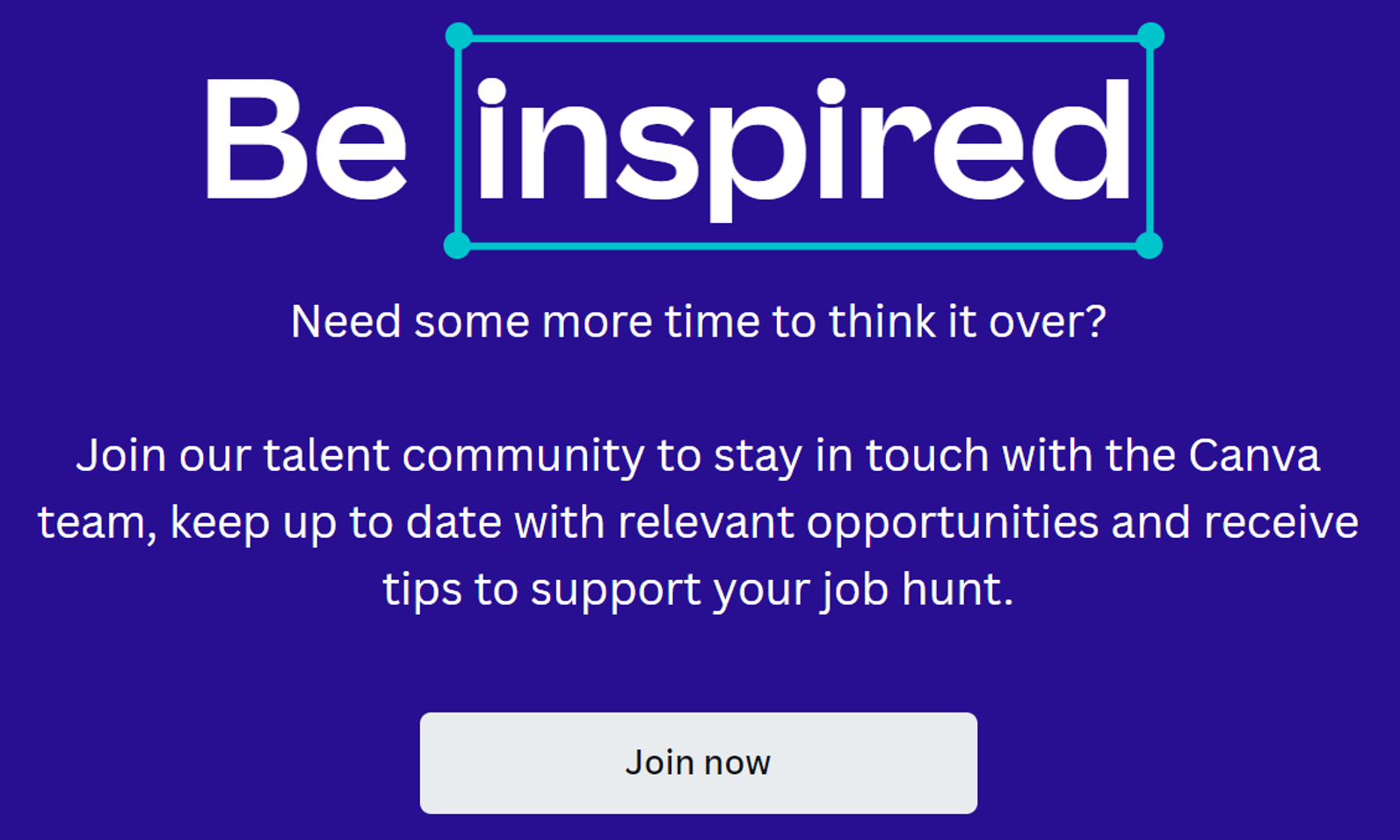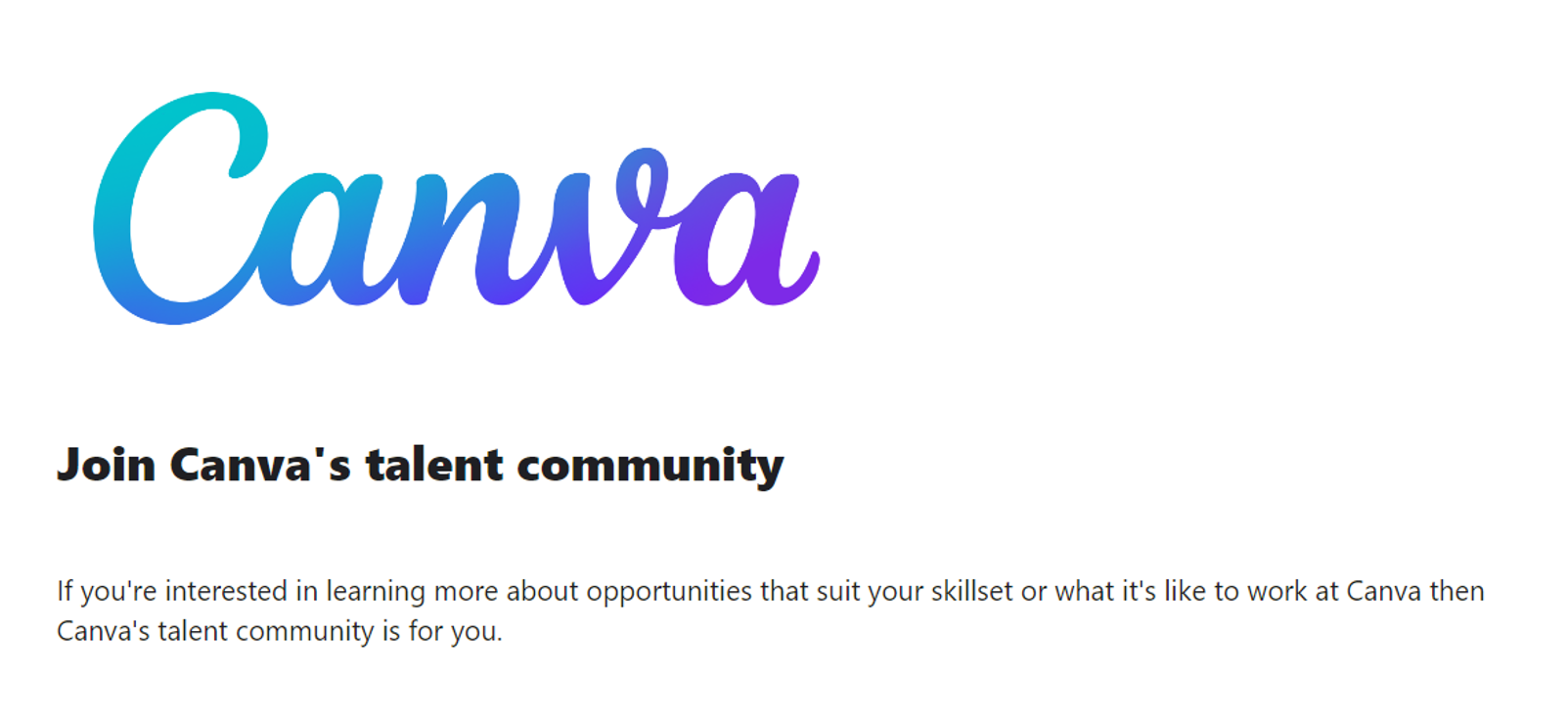-
Provided by

- Date published: Oct 9, 2023
- Categories
30-second summary
- Canva’s global team has seen a soar in new hires, growing from 1,000 to 4,000 employees in three years
- Canva’s talent community now includes over 20,000 members
- The journey from a skills-agnostic hiring approach to a skills-first mindset has supported its global expansion plans
The past few years have been incredibly busy for Canva. The online graphic design platform and app has grown from a team of three at its Sydney HQ in 2013, to 1,000 employees in 2020, to 4,000 in 2023 across London, Prague, Vienna, Austin, San Francisco, Manila, Beijing, Wuhan, and Australia. It is entering its second decade with more than $1.7 billion in annualized revenue and on track for the seventh year profitability and has also added 65 million new monthly users in the last 12 months alone. If there is a war for talent, then Canva is winning, and its talent community is playing a pivotal role.

Canva’s remarkable talent community and innovative Skills Passport are helping to identify and streamline talent, up-skill employees or ‘Canvanauts,’ and support the internal mobility program ensuring fewer skills gaps and creating a rich pool of global talent to facilitate and support its ambitious future growth plans. Amy Schultz, Global Head of Talent Acquisition, Canva, speaks with HRD Connect to discuss how Canva was able to solve the challenge of scaling an organization to such an extent, in such a short time frame.
How Canva’s talent community is achieving astronomical growth
The burgeoning Canva global talent pool counts over 20,000 potential hires from around the world. It is a testament to its strong employer brand.
“I’ve got this True North vision that one day we will never have to post a job ad again,” Schultz explains. “We know where we are, we know where they are, we know the skills our people have and that they have an affinity to work at Canva.
“Not only is that an amazing pool of talent to source from but also while people who apply might not be successful, they can opt into our talent community and stay in touch so we can invite them to our events.”

How the talent community adds value to Canva’s employer brand
This generous and nurturing approach to recruitment also sees Canva reward applicants who reach the ‘challenge’ stage of the recruitment process with a free Canva Pro subscription. “We recognize the time investment that our candidates have put in to get to that point, and again, whether they are successful or not we want them to take away something from that and hopefully become lifelong users of Canva.”
The team also invites talent communities to skills-based webinars which aim to educate about AI in Canva or job search skills. “We’ve got about 300 open roles at the moment, but we receive about 300,000 job applications a year and we’ve had 20,000 folks opt into our talent community. Our career site has been visited six million times over the last year. We are so fortunate to have a brand that so many people are interested in but that also means that we’re not able to give everybody a job. However, if applying for a role with us or joining our talent community helps them on their career journey in some way, to me that’s a win,” enthuses Schultz.
The team behind Canva’s talent community
To support the rapid growth, Schultz focused on bringing together various strands of the business to ensure maximum agility and aligning processes for the Talent Acquisition department: “My team is now structured in a way that supports a lot of the skills work that we’re doing in Canva. It represents the change within TA. They are the parts of the team that I lead, and that’s helping to create more agility not only in our hires externally, but also in how we’re thinking about moving people internally, planning for future growth, and leveraging the contingent workforce. This also includes freelancer leverage as well, which is a really strategic way of us being able to continue to grow and scale the product globally,” she explains.
Canva’s Skills Passports
One of the new innovations that have become a bedrock of Canva’s talent acquisition strategy is the idea of the Skills Passport. This concept materialized from Schultz’s own experiences and has since evolved to become a blueprint for recruitment and the wider L&D approach across the organization. It will also be fundamental to how Canva hires employees through its talent community.
“When you live overseas or travel a lot, your passport becomes so important. The stamps that you receive tell your story and there’s a thrill in that. Essentially, a passport enables adventure. The concept is that these skills allow someone to have various career adventures that they never perhaps thought possible, building the skills that enable growth and opportunity,” she explains.
Schultz says the concept was a match made in heaven for a people-centered business like Canva: “We’re not a hierarchical company, we don’t believe in career ladders, instead generally think more like a rock-climbing wall. Our CEO Melanie Perkins has a vision that every Canvanaut can develop the skills that they need to achieve bigger goals. And maybe that means they change roles, but they get to work on bigger problems and continue to help Canva achieve its own crazy big goals.”
Reimagining the recruitment process
The Skills Passport is an extension of the existing skills framework at Canva. Canva has built this framework around four key pillars: Craft, communication, leadership, and strategy. Each has skills embedded in those pillars, creating 12 in total. “From a hiring point of view, we wanted to make skills part of our hiring DNA but that stopped at the applicant tracking system stage,” says Schultz. “From our systems and tooling point of view, we are able to pull that thread of skills and the data through our hiring process.
“But it doesn’t stop there,” she continues. “It is infused from onboarding through to our growth and impact team and to Canva University, who are our kind of L&D team. We have a skills working group, a cross-functional team that I’m the sponsor for, and we’ve got staff from across the people team and our People Tech and Enablement Team to help support from a systems point of view.”
However, she notes that when scaling at pace, there needs to be a constant partnership between a recruiter and a hiring manager to keep skills front and center. “Having the Skills Passport does widen the net when we’re recruiting for roles we haven’t hired before in a new location,” Schultz notes. “But sometimes when that hiring manager is feeling the pressure to hire quickly, they can go back to revert to what they know.”
Maintaining the trajectory
As growth continues for Canva, Schultz’s priority is to maintain the upward trajectory. But she has advice for those who might be looking at a skills-based culture: “If people want to go on that journey, focusing less on qualifications and pedigree and titles and more on skills is absolutely going to widen the talent net.
“If you’re going out to market with that approach, being able to embed that throughout your business makes sense. Not just hiring, but growth and development and internal mobility. Fundamentally, you need to have the right teams working together.”








